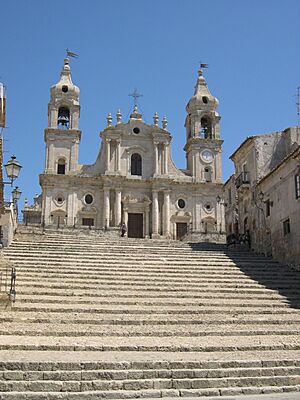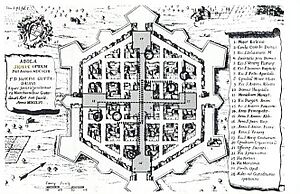Angelo Italia facts for kids
Quick facts for kids
Angelo Italia
|
|
|---|---|
| Born | 8 May 1628 Licata, Sicily, Italy
|
| Died | 5 May 1700 (aged 71) Palermo, Sicily, Italy
|
| Occupation | Jesuit and architect |
Angelo Italia was an Italian architect and a Jesuit priest. He was born on May 8, 1628, in Licata, Sicily, and passed away on May 5, 1700, in Palermo. He was known for designing many beautiful churches in Sicily. After a huge earthquake in 1693, he also helped rebuild three cities. His work is a great example of Baroque architecture, which is a fancy and dramatic style.
Contents
Biography
Angelo Italia's father was a skilled builder in Licata. Angelo learned many technical skills from him. His very first building project as an architect was the Chiesa di Sant'Angelo Carmelitano in Licata, which he started in 1653.
In November 1671, when he was 43, Angelo joined the Jesuit order. Jesuits are a group of Catholic priests and brothers. After a special training period called a novitiate in Messina, he moved to the Jesuit College in Palermo.
Angelo's designs for churches like the Holy Sacrament of Palermo and San Francesco da Saverio were very unique. This suggests he probably traveled to big Italian cities like Rome and Naples to study architecture. He likely saw the works of famous architects such as Francesco Borromini and Pietro da Cortona. In 1672, he saw the work of Guarino Guarini in Messina, which greatly influenced his own style. He might have even met Borromini there!
Between 1685 and 1692, Angelo worked for a powerful leader named Carlo Carafa Branciforte. He designed the Church of St. Mary of the Snow (Chiesa Santa Maria della Neve) in Mazzarino for him.
After a terrible earthquake hit eastern Sicily in 1693, Angelo Italia became very important. He helped design the new layouts for three cities: Avola, Lentini, and Noto. These projects made him the most important person in the rebuilding efforts.
He stayed in eastern Sicily until 1700, when he returned to Palermo. He passed away there that same year.
Works
Angelo Italia's buildings show many different influences. One special thing about his work is his use of hexagonal (six-sided) shapes. You can see this in the Chapel of the Crucifix in the Cathedral of Monreale, the Church of San Francesco Saverio in Palermo, and even in the street plan of Avola.
Architecture
- Chiesa di Sant'Angelo Carmelitano, Licata (started 1653)
- Chiesa Madre, Palma di Montechiaro (1666): This church was built by the Tomasi di Lampedusa family. It has a long main hall, side sections, and a dome. The church is made of white stone and stands proudly at the top of many steps. It shows how skilled Angelo was and how well he knew the latest architectural ideas.
- Chiesa di S. Girolamo in Polizzi (1681): This church is connected to a Jesuit college. It has a central octagonal (eight-sided) shape with chapels branching out from it.
- Church of San Francesco Saverio, Palermo (1685): Built between 1685 and 1710, this church is considered one of Angelo's masterpieces. It has a central octagonal shape, which is a mix of a Greek cross and a square. Four hexagonal chapels are connected to it, forming a kind of walkway. A large dome covers the central area, resting on strong columns. The side chapels also have small, bright domes. This design creates a complex and truly Baroque space, showing the influence of architects like Guarini and Borromini. The church was finished in 1730.
- Church of Santa Maria della Neve in Mazzarino: Carlo Carafa Branciforte asked Angelo to design this church. It was planned with one large main hall with a barrel-vaulted (rounded) roof. It was started around 1685 but was not finished in Angelo's lifetime. It was finally completed in the 1800s with three main halls.
- Chiesa del Collegio della Compagnia di Gesù (Church of the College of the Society of Jesus) in Catania: This church was rebuilt after the 1693 earthquake. Angelo created plans based on the old church's foundations. The building work took place between 1698 and 1736.
- Basilica of Santa Maria Assunta in Alcamo (1699): Angelo designed this church with another architect, Giuseppe Diamante. It has a traditional basilica plan with three main halls and many side chapels. It was built on an older site after Angelo's death.
- Chapel of the Crucifix in the Cathedral of Monreale (1672): Angelo designed this chapel with Paolo Amato. It shines with colorful marbles, showing Angelo's interest in using many colors. The walls and floor have complex Bible stories shown through inlaid designs, including a picture of Jonah's shipwreck.
- Carmine Maggiore in Palermo: Angelo designed a new dome for this church. It has unique decorations like grotesques (funny carvings), scrolls, and leaves, all decorated with bright tiles.
- Church of the Jesuits, Mazara del Vallo: This church is oval-shaped and has lively sculptures on the outside.
- Marble fountain at the former Jesuit Collegio Massimo in Palermo.
Urban Development
Avola (1693)
After the big earthquake in 1693, Angelo Italia was asked to design a new plan for the city of Avola. He chose a flat area with plenty of water and close to the sea. Even though some thought it would be hard to defend, his location was chosen. In 1694, work began on the new buildings.
The city's layout combined a hexagonal (six-sided) shape with two main streets that crossed at right angles in a central square. This design was very smart! It mixed order and open spaces with wide, straight roads. This was done to reduce damage if another earthquake happened. This plan was similar to the design used for the nearby city of Grammichele. It was seen as an "ideal Renaissance City."
A writer named Vittorini wrote in 1694 about the new city:
By order of the Prince of Santa Flavia, the Master Architect Brother Angelo Italia of the Company of Jesus was sent to that city. He was to find the best and healthiest place to rebuild the new city. Brother Angelo looked carefully at all the land around Avola. He found no better spot than the area known as Mutube. This is where the new city was moved, about one and a half miles from the sea, on a very beautiful and wide plain... The waters from the Miranda spring flow through the middle of the city. The walls of the houses around the city help protect it. They all have small openings to keep enemies away with a few guns...
—Vittorini (1694), Relatione di quanto si è operato nella nuova città d'Avola dal giorno del terremoto 11 gennaio 1693 a questa parte
Angelo Italia himself, with 50 workers, drew the plan of the new city on the ground. He marked out not only the streets and walls but also where public buildings and private homes would be.
Lentini (1693)
Just like with Avola, Angelo Italia planned to rebuild Lentini away from the ruined old city. However, the people of Lentini asked the King if they could rebuild their city on the old site instead. The King agreed, and they rebuilt it where it was before.
Noto (1693)
The old city of Noto was on top of a mountain called Mount Alveria. After the earthquake, everyone agreed to rebuild it about 10 kilometers away, on the slopes of Mount Meti. Angelo Italia was one of the key people involved in this new construction plan. He worked with other experts, including a Dutch military engineer named Carlos de Grunenberg.
See Also
- Sicilian Baroque
|





